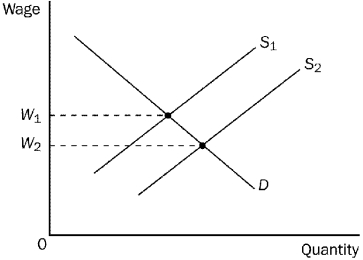Correct Answer

verified
Correct Answer
verified
Multiple Choice
Table 18-10
Consider the following daily production data for Caroline's Cookies, Inc. Caroline's sells cookies for $2.50 each and pays the workers a wage of $325 per day.
 -Refer to Table 18-10.What is the third worker's marginal product of labor?
-Refer to Table 18-10.What is the third worker's marginal product of labor?
A) 120 cookies
B) 140 cookies
C) 160 cookies
D) 180 cookies
Correct Answer

verified
Correct Answer
verified
Multiple Choice
The marginal product of labor is
A) the increase in the amount of output from an additional unit of labor.
B) the total amount of output divided by the total units of labor.
C) total revenue minus total cost.
D) also called the marginal profit.
Correct Answer

verified
Correct Answer
verified
Multiple Choice
Because workers in the U.S.economy receive most of the total income earned,which of the following factors of production is considered to be the most important?
A) profit
B) wages
C) interest
D) labor
Correct Answer

verified
Correct Answer
verified
Multiple Choice
Table 18-5
 -Refer to Table 18-5.What is the value for the cell labeled BB?
-Refer to Table 18-5.What is the value for the cell labeled BB?
A) $300
B) $200
C) $100
D) $$100
Correct Answer

verified
Correct Answer
verified
True/False
Labor-augmenting technological advances increase the marginal productivity of labor.
Correct Answer

verified
Correct Answer
verified
True/False
Labor supply curves are always upward sloping.
Correct Answer

verified
Correct Answer
verified
Multiple Choice
Consider the labor market for computer programmers.During the late 1990s,the value of the marginal product of all computer programmers increased dramatically.Holding all else equal,what effect did this process have on the labor market for computer programmers? The equilibrium wage
A) increased, and the equilibrium quantity of labor increased.
B) increased, and the equilibrium quantity of labor decreased.
C) decreased, and the equilibrium quantity of labor increased.
D) decreased, and the equilibrium quantity of labor decreased.
Correct Answer

verified
Correct Answer
verified
Multiple Choice
Which of the following statements is correct?
A) Neither economic theory nor evidence from the U.S. economy suggests that there is a close link between productivity and real wages.
B) Economic theory suggests that there is a close link between productivity and real wages, but evidence from the U.S. economy fails to confirm that link.
C) Evidence from the U.S. economy suggests a close link between productivity and real wages, but economic theory provides no basis for such a link.
D) Both economic theory and evidence from the U.S. economy suggest that there is a close link between productivity and real wages.
Correct Answer

verified
Correct Answer
verified
Multiple Choice
Which of the following would increase the demand for labor? (i) a decrease in the output price (ii) an increase in the output price (iii) a labor-saving technological advance (iv) a labor-augmenting technological advance
A) (i) only
B) (i) and (iii) only
C) (ii) only
D) (ii) and (iv) only
Correct Answer

verified
Correct Answer
verified
True/False
Technological advances can cause the labor demand curve to shift.
Correct Answer

verified
Correct Answer
verified
Multiple Choice
When labor is the only input a firm uses,the marginal cost of a unit of output can be defined as
A) the marginal revenue multiplied by the wage.
B) the marginal product of labor multiplied by the wage.
C) the wage divided by the marginal product of labor.
D) the marginal product of labor divided by the wage.
Correct Answer

verified
Correct Answer
verified
Multiple Choice
Figure 18-7
 -Refer to Figure 18-7.If the relevant labor supply curve is S₂ and the current wage is W₁,
-Refer to Figure 18-7.If the relevant labor supply curve is S₂ and the current wage is W₁,
A) there is a surplus of labor.
B) the quantity of labor demanded exceeds the quantity of labor supplied.
C) an increase in the minimum wage could restore equilibrium in the market.
D) firms will need to raise the wage to restore equilibrium.
Correct Answer

verified
Correct Answer
verified
True/False
The rental price of capital is the price a person pays to own the capital indefinitely.
Correct Answer

verified
Correct Answer
verified
Multiple Choice
Which of the following is an example of a factor of production?
A) rent
B) interest
C) land
D) Social Security payments
Correct Answer

verified
Correct Answer
verified
Multiple Choice
Total income in the United States is comprised of
A) wages only.
B) wages and fringe benefits only.
C) rents, profits, and interest payments only.
D) wages, fringe benefits, rents, profits, and interest payments.
Correct Answer

verified
Correct Answer
verified
Multiple Choice
The value of the marginal product of labor is equal to the change in
A) marginal cost caused by the addition of the last worker.
B) total cost caused by the addition of the last worker.
C) total revenue caused by the addition of the last worker.
D) total profit caused by the addition of the last worker.
Correct Answer

verified
Correct Answer
verified
Multiple Choice
Consider the market for medical doctors.Suppose the opportunity cost of going to medical school decreases for many individuals.Suppose it generally takes about ten years to become a practicing doctor.Holding all else constant,in ten years the equilibrium quantity of doctors will
A) increase.
B) decrease.
C) not change.
D) It is not possible to determine what will happen to the equilibrium quantity.
Correct Answer

verified
Correct Answer
verified
Multiple Choice
Which of the following is correct?
A) Any event that changes the supply or demand for labor must change the value of the marginal product.
B) A profit-maximizing firm hires workers so long as the wage rate exceeds the value of the marginal product of labor.
C) An increase in the supply of labor increases both employment and wages.
D) A decrease in the demand for labor decreases wages but increases employment.
Correct Answer

verified
Correct Answer
verified
Multiple Choice
The value of the marginal product of labor is calculated by multiplying the
A) price of output by the quantity of labor.
B) price of output by the marginal product of labor.
C) wage by the quantity of labor.
D) wage by the marginal product of labor.
Correct Answer

verified
Correct Answer
verified
Showing 261 - 280 of 463
Related Exams